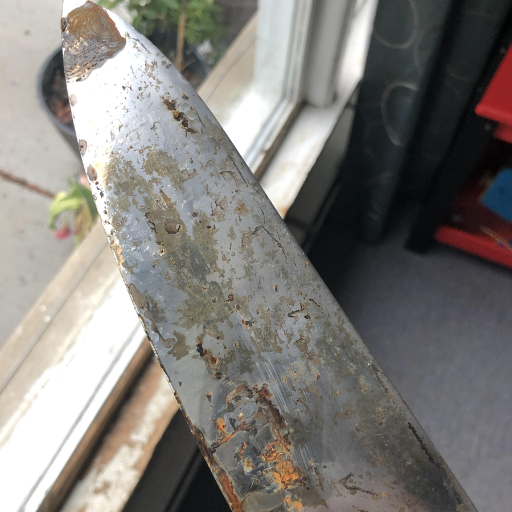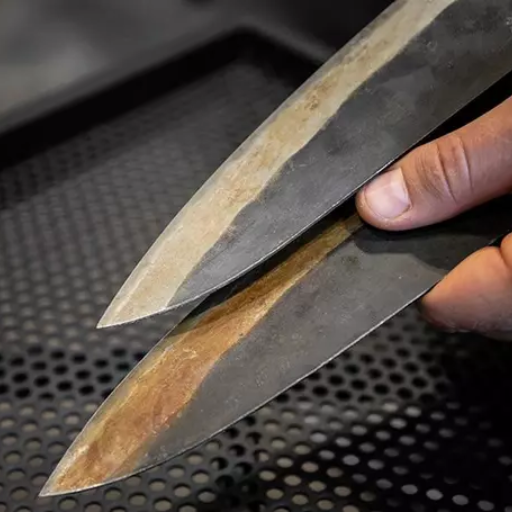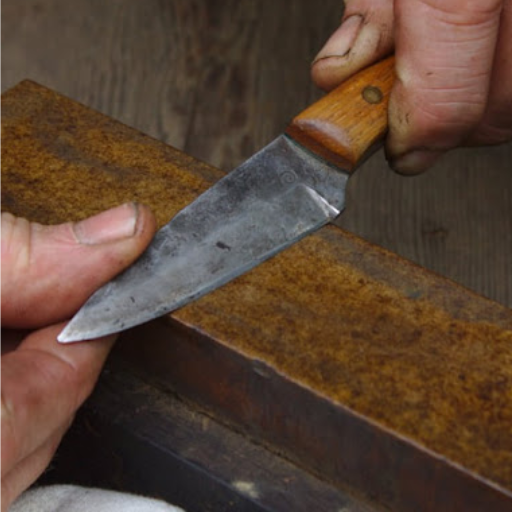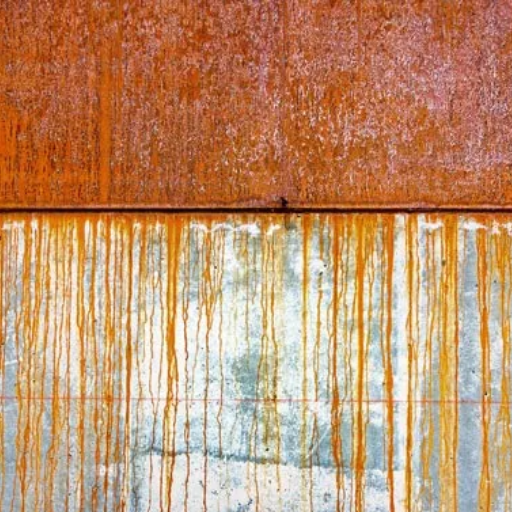High carbon steel is well regarded for its incredible strength and versatility, however, the material’s propensity to rust is an area of concern for manufacturers, hobbyists, and industry professionals alike. To grasp the nature of high carbon steel and corrosion, it is indispensable to comprehend it if you are dealing with or utilizing this material. Does this durable steel truly rust? If so, how can its lifespan be preserved? This article explores in detail the characteristics of high carbon steel, analyzing what makes it susceptible to rusting and looking into how better strategies can be adopted to resist corrosion. This guide serves to answer the questions whether you are making tools, working on a project, or just want to learn more, and aid you in deciding about the use and maintenance of high carbon steel.
What Makes High-Carbon Steel Prone to Rust?

High-carbon steel is susceptible to rust because it contains iron, which will interact with the oxygen and water in the atmosphere and develop rust or iron oxide. This reaction takes place naturally, with minimal protection being offered due to the high carbon content of steel and brittleness. The carbon does make the steel more brittle, leading to microcracks that moisture can gather in. Also, high-carbon steel does not have chromium, unlike stainless steel, which aids in the formation of protective oxide layers to prevent rusting. It is important to take proper maintenance and care of the steel by keeping it dry, applying protective paints and coatings, and using anti-rust chemicals to mitigate the corrosion effects.
Understanding the Composition of Carbon Steel
The primary components of carbon steel are iron and carbon, which contain as little as 0.05% carbon and as much as 2.1% by weight. This range of carbon content affects the steel’s properties, such as its hardness, ductility, and tensile strength. The American Iron and Steel Institute (AISI) categorizes carbon steel into four main groups based on the amount of carbon they possess:
- Low Carbon Steel (Mild Steel): Contains 0.05% to 0.25% carbon. This type of steel possesses a great degree of ductility which allows it to be easily welded or machined. Its typical use is found in construction, auto manufacturing, and other types of structural work.
- Medium Carbon Steel: Contains 0.25% to 0.60% carbon. This steel is relatively ductile while retaining some strength, making it ideal in the manufacturing of more demanding parts like gears, axles, and structural components due to its increased toughness.
- High Carbon Steel: Contains 0.60% to 1.0% carbon. This type of steel is tougher and more brittle than lower-carbon steels. Its typical applications include tools, springs, and high-strength wire.
- Ultra-High Carbon Steel: Contains 1.0% to 2.1% carbon. Ultra-high carbon steel has specialized uses in items such as cutting tools where its extraordinary hardness can be most useful, but can also be used in knives.
Besides the main constituents, other elements such as manganese, silicon, and small amounts of sulfur and phosphorus are sometimes incorporated to improve the properties of carbon steel. Manganese, for example, enhances strength and toughness while silicon increases both the hardness and elasticity.
Mechanical Properties and Uses
The mechanical properties of carbon steel differ according to the percentage of carbon it possesses. For example:
- Tensile Strength (Typical Values): Characteristically, the tensile strength of low carbon steel is approximately 400 to 550 MPa, and that of high carbon steel is more than 800 MPa.
- Hardness (Rockwell Scale): Generally, low carbon steel has a hardness of about 55-60 HRB, whereas high carbon steel has a hardness of 60-65 HRC and above.
Besides being cost effective and readily available, carbon steel is among the most widely used materials in engineering and manufacturing owing to its tailored mechanical properties, which makes it indispensable in construction, automotive, and infrastructure industries.
Gauging the composition and types of carbon steels enables steel producers to optimize performance while engineering costs by choosing the right grade for specific applications.
Why Carbon Steel Rusts Easily When Exposed to Moisture
| Key Point | Details |
|---|---|
| Main Component | Carbon steel is primarily iron and carbon. |
| Lacks Chromium | No protective chromium oxide layer like stainless steel. |
| Oxidation Reaction | Iron reacts with oxygen and water to form rust (iron oxide). |
| Moisture’s Role | Water accelerates the oxidation process. |
| Environmental Factors | High humidity, salt, and temperature changes increase rusting. |
| Rust Formation | Rust absorbs moisture, worsening corrosion over time. |
| Protection Methods | Coatings, paints, and rust inhibitors prevent moisture contact. |
| Maintenance | Regular cleaning and drying reduce rust risk. |
| Comparison to Stainless | Stainless steel resists rust due to chromium content. |
How Iron and Carbon Content Contribute to Rust Formation
The composition of iron and carbon in steel greatly influences its tendency to rust. Carbon content, along with other impurities, can either speed up or slow down the corrosion process when combined with certain environmental conditions. Here are five factors involving iron and carbon that contribute to rusting:
- High Carbon Content
The addition of carbon to steel improves hardness, but decreases steel’s resistance to corrosion. The rusting risk increases due to microstructural changes brought about by excess carbon.
- Presence of Impurities
Certain alloys of iron and carbon contain impurities like sulfur or phosphorus, which greatly increase the risk of localized corrosion on the surface of steel.
- Alloy Composition
Protective alloying elements such as chromium are absent in low-carbon steel. This absence increases oxidative reactions in the presence of water which makes the surface vulnerable.
- Electrochemical Reactions
Localized galvanic cells may form due to carbon inclusions, which cause certain areas of the metal to corrode at faster rates than the rest and, in doing so, create rust.
- Grain Structure
Iron-carbon alloys that have uneven grain structures due to lack of refining during processes display increased rates of corrosion from structural weaknesses.
Consideration of these attributes helps when creating steel for specific purposes, especially when considering the need for resistance against corrosion.
How Does High Carbon Steel Compare to Stainless Steel?

The properties and uses of high carbon steel and stainless steel vary greatly. High carbon steel is famous for its strength and hardness, meaning it is ideal for tools, cutting instruments, or any other applications that require durability. Additionally, however, high carbon steel is more prone to rust and corrosion due to the lack of chromium when compared to other steels. Conversely, stainless steel has a much higher content of chromium, which helps form an oxide protective layer, resulting in better corrosion resistance. This makes stainless steel more suitable for use in moist or chemical environments such as kitchens and medical apparatsulfurses. While high carbon steel is stronger, stainless steel is more well-liked due to its long-lasting and low-maintenance nature.
Key Differences Between Carbon Steel vs Stainless Steel
| Parameter | Carbon Steel | Stainless Steel |
|---|---|---|
| Composition | High carbon, low chromium | At least 10.5% chromium |
| Corrosion Resistance | Prone to rust and corrosion | Highly resistant to rust and corrosion |
| Strength | Stronger and harder | Lower strength, more ductile |
| Appearance | Matte finish | Shiny and lustrous |
| Cost | Generally cheaper | More expensive |
| Heat Resistance | Moderate heat resistance | Superior heat resistance |
| Machinability | Easier to machine and weld | Requires specialized tools |
| Applications | Tools, knives, construction | Medical, food equipment, and decorative items |
The Role of Chromium in Stainless Steel
| Key Point | Details |
|---|---|
| Minimum Content | At least 10.5% chromium in stainless steel. |
| Corrosion Resistance | Forms a protective chromium oxide layer. |
| Rust Prevention | Chromium prevents rust by blocking oxygen contact. |
| Hardness | Enhances steel hardness and toughness. |
| Wear Resistance | Improves wear resistance and durability. |
| Aesthetic Appeal | Provides a shiny, lustrous finish. |
| Heat Resistance | Increases resistance to high temperatures. |
| Passivation | Promotes a self-healing protective layer. |
| Applications | Used in tools, medical devices, and construction. |
Examining Corrosion Resistance in High-Carbon Steel
Incredibly strong and durable, high-carbon steel does not contain the corrosion resistance of stainless steel. Without a protective barrier, high-carbon steel is prone to oxidation when it is exposed to moisture or humid air. To reduce this risk, high-carbon steel is often covered with protective coatings or finishes. However, maintaining long-term protection with these coatings or finishes requires consistent upkeep.
Can You Prevent Carbon Steel from Rusting?

Yes, carbon steel can be maintained by applying certain steps to stop rusting. Carbon steel should be cleaned and dried to prevent dirt and moisture, which are corrosive elements, from penetrating the surface. Protected paint oil or wax can be applied to the surface to act as a barrier against moisture and oxygen. It can also be stored in places with low humidity and dry air to prevent contact with water. Advanced techniques like galvanization where a zinc layer is added can also be used for adding more durability.
Effective Methods to Prevent Rust on Carbon Steel
| Method | Details |
|---|---|
| Clean and Dry | Remove dirt, grease, and moisture thoroughly. |
| Apply Protective Coatings | Use paint, wax, or anti-corrosion solutions. |
| Use Oil or Grease | Apply a thin layer to repel moisture. |
| Galvanization | Coat steel with zinc for sacrificial protection. |
| Use Desiccants | Place silica gel to absorb moisture. |
| Proper Ventilation | Ensure air circulation to reduce humidity. |
| Regular Maintenance | Inspect and reapply coatings as needed. |
| Environmental Control | Use dehumidifiers or climate-controlled storage. |
| Sacrificial Anodes | Attach zinc or magnesium to protect steel in water. |
Using Protective Layers and Coatings
Rust prevention methods include applying oil or wax to carbon steel, along with specialized coatings and even powder galvanization for long-lasting protection.
Regular Maintenance to Help Prevent Rust
To maintain carbon steel in pristine condition and effectively prevent rusting from occurring, you need to implement regular maintenance. Complete the following five steps to optimize your carbon steel:
- Frequently Clean the Surface
Soils, oils, and moisture are best removed by utilizing a soft, dry cloth or a slightly wet cloth.. This step helps keep your carbon steel surface clean and prevents contaminants that could speed up rusting.
- Drying Completely After Water Exposure
Thoroughly wiping the material down if any water spills on it is essential to preventing sustained contact with moisture since this can lead to rust formation.
- The Application of Rust Prevention Solutions
There are several rust inhibitors and supplies to aid in preventing rust.. By using sprays and rust-resistant oils, a protective barrier can be formed around the surface that prevents the entry of water and oxygen, slowing oxidation.
- Conducting inspections of the Rust forming
Repetitively assess surfaces for signs of rust formation. Using tools such as sanders or rust removers can aid in early detection and prevention of an issue that has the potential to worsen with neglect.
- Properly controlled storage environment
Eliminating triadics of temperature and humidity is key- as these help expedite the rate at which rust forms. Using dehumidifiers and silica gel packets can also aid in flooring the carbon steel in a dry, temperature controlled environment.
What Are the Best Practices for Rust Removal on Carbon Steel?

- Remove Rust with a Commercial Solution
A commercial rust remover a vinegar, or a baking soda solution can be applied. These products assist in dissolving rust.
- Scrub Manually
Grasp a wire brush, steel wool, or sandpaper, and gently scrub over the rusty metallic surface. Ensure to work along the metal grain to prevent unnecessary damage.
- Use the Electrolysis Method
Using a electrolysis setup for severe rust problems will aid in lifting or removing rust without harming the underlying metal.
- Complete Rinse and Dry
Post removal of rust, clean the surface with water and ensure it is dried thoroughly to prevent further corrosion.
- Coat the Surface to Be Protected
After the rust removal process is done, one should apply oil, wax, or a rust inhibitor to prevent future rust formation.
Advanced Insights on Removing Rust Safely
For efficient long-term rust protection, using innovative methods with proven techniques is crucial. Consider the options presented below alongside modern literature.
- Vinegar – A Remedy for Minor Rust
Vinegar, particularly white vinegar, is a common household item that has been shown to effectively clear minor rust. The acetic acid present will naturally dissolve rust over time. Studies show that soaking rusted items in vinegar for 12 to 24 hours improves the condition greatly, as well as the addition of scrubbing tough areas with gentle brushes post-soak.
- Baking Soda As An Abrasive with Care
Even with its gentle nature, some items need baking powder as a non-toxic abrasive. When mixed with water, it creates a paste that can gently scrub the surface and remove rust particles. Studies suggest that these defeated scratches make baking powders an outstanding addition to combating hazardous materials.
- The Power Of Oxalic Acid
Oxalic acid can be procured from some rust removers and works exceptionally well on heavy rust deposits found on strong surfaces. Oxalic acid is very powerful and helpful, but as with any other chemical, one needs to handle it with care because of its destructive potential. It is always recommended to put on gloves while applying the chemical and to follow the instructions on the product. Recent studies claim that when oxalic acid is correctly applied, metallic structures can be restored up to an astonishing 90% of their former glory.
- Rust Converter for Ongoing Protection
More recent products have received praise for their rust converter feature that serves a double purpose. They not only help cover the corroded area but also impede further corrosion by transforming the degenerated metal into an inactive protective structure. Reviews show that products with tannic acid and 2 2-butoxyethanol have the best results from market surveys in completing a lasting protective layer.
- Electrolysis For Advanced Situations
Electrolysis is among the best-tried methods for the conservation of old, historical, or any delicate metal objects. The application of electrical currents for rust reduction works effectively by placing the rusted item into an electrolyte solution and passing low-level currents. Portable electrolysis systems that have been innovated in recent years prove to be extremely useful by providing up to a 95% success rate in deep rusted complex objects.
- Prevention: Because of Regular Maintenance
Research suggests that the best method to deal with rust is to try to stop it from forming in the first place. Protecting metal objects during cleaning, applying proper sealants, and placing them in low humidity areas on an ongoing basis are very effective methods. Silica gel sachets used in the storage areas can lower humidity up to 30% helping prevent corrosion remarkably.
When these guidelines are followed in combination with the most recent technologies, removing rust is effortless, safe, and eco-friendly. Always take into consideration the material and extent of rust present in order to achieve the best outcome.
Tools and Products for Effective Rust Removal
- Wire Brushes and Sanding Paper
Both wire brushes and sandpapers have been used for years to scrub surfaces containing rust (sanding paper being more appropriate for scratches). Sanding paper is appropriate for surfaces with a lighter amount of rust. Sanding disks that fit power tools such as drills are extremely helpful for larger surfaces. All of these tools are quite cheap and can be found everywhere.
- Rust Convertor
These aid in getting rid of rust that has already formed by changing its chemical state into a more stable one. It is very effective when you need to paint it later. Various types of phosphoric acid based rust converters are very effective and can be applied either by brush or spray.
- White Vinegar
An alternative that is more gentle on the environment is the use of white vinegar. It can dissolve rust that is not very thick because of its prowess in acids. To achieve the desired results, all that is needed is to soak the rusty object for a couple of hours, then scrub it with a sponge or a scrubber. This is one of the cheapest ways to remove rust and is safe on many metal surfaces.
- Electrolysis Setup
This is one of the most advanced methods out there to get rid of rust, especially if it is found on delicate parts of a complicated structure. It consists of a nonmetallic container filled with water mixed with washing soda, and a DC power supply. It aids in stripping away rust without damaging the item itself. If prepped correctly, this technique yields great results.
- Rust Remover Gels and Solutions
Oxalic acid-containing specialized rust remover gels and solutions deliver targeted applicative action on hard rust spots. These products work well on vertical surfaces, as gels do not drip and remain in place. For optimal results, always follow the manufacturer’s directions and proper safety measures.
How to Restore Carbon Steel’s Original Finish
To bring back the finish of carbon steel, remove rust and debris, scrub it clean, dry it completely, and reseason with a high-smoke-point oil while applying thin layers and heating until a smooth, dark patina appears.
Why Is Carbon Steel Still Popular Despite Its Vulnerability to Rust?

Despite its rust tendencies, carbon steel’s strength, affordability, and versatility keep it in demand. Widely utilized in construction, tools, and machinery, carbon steel can withstand tremendous weight while still maintaining its durability under stress. Moreover, easily working with steel makes it ideal for welding and shaping. It’s even more appealing when considering other alloys due to its cost-effectiveness on larger-scale projects. While maintenance and protective coatings can mitigate rust, proper steam ensures usability for long-term purposes.
The Toughness and Durability of Carbon Steel
| Key Point | Details |
|---|---|
| High Strength | Excellent tensile and yield strength properties. |
| Good Toughness | Resists cracking and breakage under stress. |
| Ductility | It can be stretched or shaped without breaking. |
| Wear Resistance | High durability in abrasive environments. |
| Heat Treatability | It can be heat-treated to enhance strength and hardness. |
| Versatility | Suitable for construction, machinery, and tools. |
| Impact Resistance | Absorbs energy from sharp blows effectively. |
| Cost-Effective | Affordable compared to other high-strength materials. |
| Corrosion Susceptibility | Prone to rust without protective coatings. |
Advantages of a Carbon Steel Knife
| Key Point | Details |
|---|---|
| Superior Sharpness | Achieves and maintains a razor-sharp edge. |
| Edge Retention | Holds its edge longer than stainless steel. |
| Ease of Sharpening | Quick and simple to sharpen effectively. |
| Toughness | Handles heavy-duty tasks like chopping and prying. |
| Patina Formation | Develops a protective, unique patina over time. |
| Cost-Effective | Generally, more affordable than stainless steel. |
| Versatility | Suitable for various cutting tasks and environments. |
| Traditional Appeal | Preferred by blacksmiths for forging and custom designs. |
The Aesthetic Appeal of Patina on Carbon Steel
The patina on carbon steel gives it an unique aesthetic appeal that I cherish. With a well-loved and rustic appearance over time, it brings character to the metal. Personally, the process of natural aging enhances it’s individuality , unlike any other. Apart from the marking gold charm, patina also provides a balance between protection and beauty that I personally find tremendously rewarding.
References
- Evolution of rust layers on carbon steel and weathering steel in high humidity and heat marine atmospheric corrosion – Published on ScienceDirect, this study explores the corrosion process and rust layer formation on carbon steel under specific environmental conditions. Source
- Marine atmospheric corrosion of carbon steel: A review – Published by MDPI, this review examines the atmospheric corrosion of carbon steel, particularly in marine environments. Source
- Influence of outer rust layers on corrosion of carbon steel and weathering steel during wet–dry cycles – Another study from ScienceDirect, focusing on the role of rust layers in the corrosion process of carbon steel. Source
Frequently Asked Questions (FAQ)
Q: Does high carbon steel rust?
A: Yes, high carbon steel will rust when exposed to moisture and oxygen because it lacks the alloying elements that make some other types of steel, such as stainless steel, more corrosion resistant.
Q: How does the amount of carbon affect the rusting of steel?
A: The amount of carbon in steel affects its strength and hardness. However, higher carbon content makes carbon steel more susceptible to rust if exposed to moisture because it lacks protective alloying elements like nickel or chromium.
Q: What are the differences between carbon steel and stainless steel in terms of rusting?
A: Carbon steel will rust if exposed to moisture and oxygen, while stainless steel contains alloying elements like chromium that form a protective layer of iron oxide, making it more corrosion resistant.
Q: Can alloy steel resist corrosion better than high carbon steel?
A: Yes, alloy steel, which includes additional elements such as nickel or chromium, can resist corrosion better than high carbon steel, which primarily consists of carbon and iron.
Q: Why is stainless steel preferred over carbon steel for kitchen knives?
A: Stainless steel is preferred for kitchen knives because it is more corrosion resistant than carbon steel due to its alloying elements, making it less likely to rust in high humidity environments.
Q: What role do alloying elements play in corrosion resistance?
A: Alloying elements like chromium, nickel, and titanium in steel alloys form a protective layer that prevents oxidation, thereby enhancing the metal’s ability to resist corrosion.
Q: How does moisture and oxygen contribute to the rusting of carbon steel?
A: Moisture and oxygen react with the surface of carbon steel, leading to the formation of iron oxide, commonly known as rust, which deteriorates the metal over time.
Q: Are there types of carbon steel that are more resistant to rust?
A: While all types of carbon steel are susceptible to rust, medium carbon steel and low carbon steel may have slightly different rates of corrosion, but neither is as corrosion resistant as stainless steel or certain alloy steels.
Q: How can one prevent high carbon steel from rusting?
A: To prevent high carbon steel from rusting, one can apply protective coatings, keep it dry, or use it in environments where exposure to moisture and oxygen is minimized.
Q: What is the impact of oxidation on iron and steel?
A: Oxidation leads to the formation of rust on iron and steel, weakening the metal’s structure over time and reducing its overall durability and lifespan.







